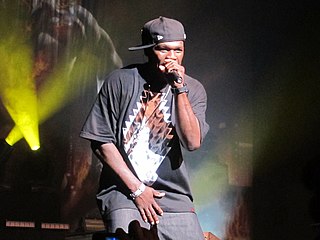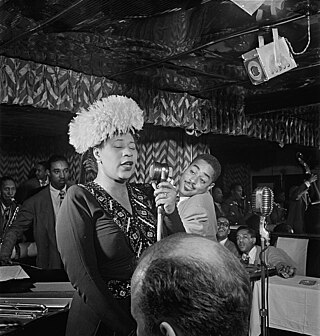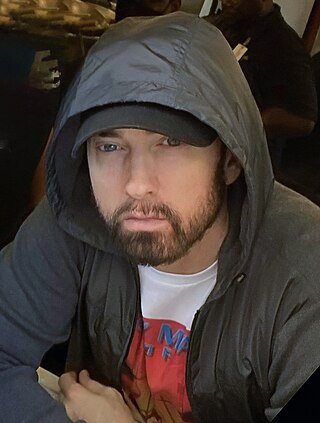Related Research Articles

Rapping is an artistic form of vocal delivery and emotive expression that incorporates "rhyme, rhythmic speech, and [commonly] street vernacular". It is usually performed over a backing beat or musical accompaniment. The components of rap include "content", "flow", and "delivery". Rap differs from spoken-word poetry in that it is usually performed off-time to musical accompaniment. It also differs from singing, which varies in pitch and does not always include words. Because they do not rely on pitch inflection, some rap artists may play with timbre or other vocal qualities. Rap is a primary ingredient of hip hop music, and so commonly associated with that genre that it is sometimes called "rap music".

Originating in vocal jazz, scat singing or scatting is vocal improvisation with wordless vocables, nonsense syllables or without words at all. In scat singing, the singer improvises melodies and rhythms using the voice solely as an instrument rather than a speaking medium. This is different from vocalese, which uses recognizable lyrics that are sung to pre-existing instrumental solos.
Old-school hip hop is the earliest commercially recorded hip hop music and the original style of the genre. It typically refers to the music created around 1979 to 1983, as well as any hip hop that does not adhere to contemporary styles.

Christopher George Latore Wallace, better known by his stage names The Notorious B.I.G., Biggie Smalls, or simply Biggie, was an American rapper. Rooted in East Coast hip hop and particularly gangsta rap, he is widely considered one of the greatest rappers of all time. Wallace became known for his distinctive laid-back lyrical delivery, offsetting the lyrics' often grim content covering struggles such as depression and suicide.

Richard Martin Lloyd Walters, better known as Slick Rick, is an English-American rapper and record producer. He rose to prominence as part of Doug E. Fresh & the Get Fresh Crew in the mid-1980s. Their songs "The Show" and "La Di Da Di" are considered early hip hop classics. "La Di Da Di" is one of the most sampled songs in history.

Nathaniel Thomas Wilson, better known by his stage name Kool G Rap, is an American rapper. He began his career in the mid-1980s as one half of the group Kool G Rap & DJ Polo and as a member of the Juice Crew. He is widely considered to be one of the most influential and skilled MCs of all time, and a pioneer of mafioso rap/street/hardcore content and multisyllabic rhyming. On his album The Giancana Story, he stated that the "G" in his name stands for "Giancana", but on other occasions he has stated that it stands for "Genius".
A rhyme scheme is the pattern of rhymes at the end of each line of a poem or song. It is usually referred to by using letters to indicate which lines rhyme; lines designated with the same letter all rhyme with each other.
Freestyle is a style of hip hop where an artist improvises an unwritten verse from the head, with or without instrumental beats, in which lyrics are recited with no particular subject or structure. It is similar to other improvisational music, such as jazz, where a lead instrumentalist acts as an improviser with a supporting band providing a beat. Freestyle originally was simply verse that is free of style, written rhymes that do not follow a specific subject matter, or predetermined cadence. The newer style with the improvisation grew popular starting in the early 1990s. It is now mainly associated with hip hop.
Underground hip-hop is an umbrella term for hip hop music that is outside the general commercial canon. It is typically associated with independent artists, signed to independent labels or no label at all. Underground hip hop is often characterized by socially conscious, positive, or anti-commercial lyrics. However, there is no unifying or universal theme – AllMusic suggests that it "has no sonic signifiers". "The Underground" also refers to the community of musicians, fans and others that support non-commercial, or independent music. Music scenes with strong ties to underground hip hop include alternative hip hop and conscious hip hop. Many artists who are considered "underground" today were not always so, and may have previously broken the Billboard charts.
In poetry, internal rhyme, or middle rhyme, is rhyme that occurs within a single line of verse, or between internal phrases across multiple lines. By contrast, rhyme between line endings is known as end rhyme.

The word orange is a noun and an adjective in the English language. In both cases, it refers primarily to the orange fruit and the color orange, but has many other derivative meanings.

Rashia Tashan Fisher, known professionally as Rah Digga, is an American rapper and actress. She is best known as a longtime member of the Flipmode Squad, a hip hop group led by Busta Rhymes. Her debut album, Dirty Harriet (2000), peaked in the top-20 of the Billboard 200, and she released her second album, Classic, in 2010. She starred in the horror film Thirteen Ghosts (2001) as Maggie.

Marshall Bruce Mathers III, known professionally as Eminem, is an American rapper. He is credited with popularizing hip hop in Middle America and is often regarded as one of the greatest rappers of all time. His global success and acclaimed works are widely regarded as having broken racial barriers for the acceptance of white rappers in popular music. While much of his transgressive work during the late 1990s and early 2000s made him a controversial figure, he came to be a representation of popular angst of the American underclass and has been cited as an influence by and upon many artists working in various genres.
Perfect rhyme — also called full rhyme, exact rhyme, or true rhyme — is a form of rhyme between two words or phrases, satisfying the following conditions:

Battle rap is a type of rapping performed between two or more performers that incorporates boasts, insults, wordplay and disses. Battle rap is often performed, or freestyled, spontaneously in live battles known as Rap battles, where participants will compete on the same stage to see who has the better verses.

A hype man, typically in hip hop music, is a backing vocalist who supports the primary performer with exclamations, interjections, or ad-libs in an attempt to increase an audience's excitement or engagement.

When rapping, MCs use braggadocio to boast—to speak about themselves with great pride. Braggadocio may include subjects such as physicality, fighting ability, financial riches, sexual prowess, or "coolness". Often heavily used in battle rap, braggadocio lyrics can range from just saying, "I'm the best MC ever," to using elaborate phraseology and wit.

How to Rap: The Art & Science of the Hip-Hop MC is a book on hip hop music and rapping by Paul Edwards. It is compiled from interviews with 104 notable rappers who provide insights into how they write and perform their lyrics.

Troy Donald Jamerson, better known by his stage name Pharoahe Monch, is an American rapper known for his complex lyrics, intricate delivery, and internal and multisyllabic rhyme schemes.
"Legacy" is a song by American rapper Eminem. It is the sixth track on his eighth studio album The Marshall Mathers LP 2 (2013). The song discusses Eminem's dysfunctional childhood. The song was produced by American record producer Emile Haynie and written by Eminem, Polina Goudieva, David Brook, and Emile Haynie. The song features additional vocals from Russian singer-songwriter Polina. "Legacy" was met with generally positive reviews from music critics upon the album's release. The song has since peaked at number 44 on the US Billboard Hot R&B/Hip-Hop Songs. "Legacy" became one of the official theme songs of WrestleMania XXX.
References
- Edwards, Paul (2009). How to Rap: The Art & Science of the Hip-Hop MC. Chicago Review Press, ISBN 1-55652-816-7.
- The craft of lyric writing. Sheila Davis 1985 Writer's Digest Books ISBN 0-89879-149-9
- "Fishing by Obstinate Isles: Modern and Postmodern British Poetry and American Readers" Keith Tuma 1998 Northwestern University Press ISBN 0-8101-1623-5